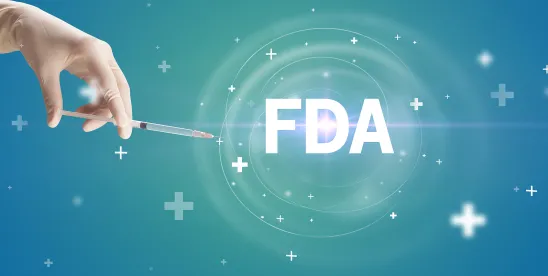On January 7, 2025, the U.S. Food and Drug Administration (“FDA” or “Agency”) released a long-awaited guidance titled, “Communications From Firms to Health Care Providers Regarding Scientific Information on Unapproved Uses of Approved/Cleared Medical Products: Questions and Answers” (the “Guidance”).[1] The Guidance is a finalized version of the draft guidance released in 2023 (the “Draft Guidance”), which we covered here, and updates FDA’s collection of guidances on the topic, including its 2014 draft guidance titled, “Distributing Scientific and Medical Publications on Unapproved New Uses — Recommended Practices” (the “2014 Draft Guidance”)[2] and its 2009 guidance titled, “Good Reprint Practices for the Distribution of Medical Journal Articles and Medical or Scientific Reference Publications on Unapproved New Uses of Approved Drugs and Approved or Cleared Medical Devices” (the “2009 Guidance”).[3]
This is a long time coming, and the changes from the Draft Guidance appear to be a step toward a more permissive policy that facilitates critical scientific exchange within the life sciences industry. In the Guidance just issued, FDA updates its framework for communicating scientific information about unapproved uses of approved or cleared medical products to healthcare providers (“HCPs”) and outlines its enforcement policy and recommendations to ensure that such communications are informative, truthful, and non-misleading.
Background on FDA’s Regulation of SIUU Communications
HCPs often prescribe FDA-cleared and/or -approved products for uses other than the intended use cleared and/or approved by FDA for the product (i.e., “off-label” uses) when medically appropriate for specific patients, especially when no proven alternative treatments exist – and under the Food, Drug, and Cosmetics Act (the “FDCA”), they’re free to do so. However, the FDCA generally prohibits manufacturers of FDA-cleared and/or -approved drugs, devices, and biologics from promoting these products for any off-label use. Therefore, FDA is tasked with protecting public health by balancing HCPs’ need for information on unapproved uses with its general prohibition against the promotion of medical products for off-label uses.
In the 2009 Guidance and subsequent 2014 Draft Guidance, FDA established a narrow exception to its general prohibition against off-label promotion for scientific information – including scientific or medical reference texts, and/or clinical practice guidelines – that discusses off-label uses for FDA-cleared or -approved products provided by manufacturers to HCPs. In the 2009 Guidance and 2014 Draft Guidance, FDA outlined then-current parameters and best practices for providing scientific information to HCPs in a compliant manner under the FDCA.
The Draft Guidance further revised these previous guidances, most notably by expanding the scope, and clarifying important definitions, including scientific information on unapproved uses of a medical product (“SIUU”).
The final Guidance largely reflects the best practices for disseminating SIUU established throughout the prior guidances, but makes important changes that ease certain requirements and clarify definitions and parameters of FDA’s policy.
Key Changes in Final Guidance
The recent Guidance largely mirrors the Draft Guidance, with some significant revisions and additions penned in response to important criticisms raised during the Draft Guidance’s comment period. For example, commenters encouraged FDA to limit the scope of its enforcement policy and refrain from suggesting that early stage clinical trial data is insufficient to support SIUU communications, alleging that these features of the guidance may have a chilling effect on the communication of truthful, scientific information from manufacturers to HCPs.
In response to these and other comments, FDA adjusted and more clearly defined the scope of the final Guidance. Perhaps more significantly, FDA also modified its stance on the use of clinical trial data in SIUU communications. In the Draft Guidance, FDA stated that SIUU communications should be “based on studies and analyses that are scientifically sound and provide clinically relevant information,” and cautioned against using early-stage clinical data in SIUU communications,[4] specifically citing instances in which Phase 3 results diverged from Phase 2 results, illustrating that Phase 2 data used in SIUU communications could be misleading or inaccurate. However, in the new Guidance, FDA loosened its standard, requiring only that SIUU communications be based on studies and analyses that are “statistically sound” (but omitting the clinical relevance requirement set forth in the Draft Guidance). Moreover, FDA clarified that data from a properly-conducted, early-phase clinical study may be used to form a so-called “scientifically sound” source publication for an SIUU communication, removing its previous discourse on divergent results altogether. These changes signify a marked change in tone for FDA that gives manufacturers greater freedom in sourcing supporting information for SIUU communications.
Additionally, FDA clarified that so-called “persuasive marketing techniques” – which are not allowed in SIUU communications – include emotional appeals unrelated to the scientific content, jingles, and promotional tag lines. We have previously noted FDA’s apparent grudge against dancing in advertising and promotion[5] and jingles appear to be FDA’s newest gripe with respect to more whimsical product promotion.
Further, FDA clarified that SIUU communications should be separated from promotional materials and excluded from specific media platforms. Notably, online platforms with character limitations could restrict a manufacturer from fully disclosing all necessary information in a SIUU communication. However, despite these SIUU-specific limitations, FDA identifies some of the same themes as it has in guidances for other types of drug and device promotion, such as sufficient disclosure and balancing of competing interests.
An important addition to the final Guidance is communicated through a footnote and essentially allows for the sharing of SIUU communications to HCPs by anyone with specialized training.[6] Significantly, sharing SIUU communications is not limited to someone in scientific or medical affairs – allowing any representative from a firm to share so long as they have the requisite training in providing truthful, non-misleading scientific information about unapproved uses of the firm’s approved medical products and training in handling potential questions that might arise from the information shared, including directing HCPs to the best qualified to respond.
Finally, in the new final Guidance, FDA included a glossary of defined terms, as well as more detailed examples of compliant SIUU communications, including reprints, clinical practice guidelines, reference texts, and manufacturer-generated presentations.
Takeaways
While both the Draft Guidance and the new final Guidance aim to guide manufacturers in their communications with HCPs regarding off-label uses of FDA-cleared or -approved medical products, the new final Guidance establishes a more permissive approach to SIUU communications, addressing the First Amendment concerns about chilling speech that were raised in numerous comments from industry stakeholders.
Interestingly, FDA seems to have significantly backed off on the hardline stances it had previously taken regarding the types of data it deems sufficient to support SIUU communications. By permitting, in certain circumstances, the use of “early-phase clinical data” and/or “preliminary scientific data,” and eliminating the “clinically relevant” requirement, FDA is being more permissive with the type of support manufacturers may use to back their communications with HCPs. Here, FDA is not holding manufacturers to produce clinical findings that live up to the standard needed to, for example, be granted approval to market a drug; rather, FDA has whittled its expectation down to the “scientifically sound” standard. Based on the changes between the Draft and final Guidance, manufacturers may consider expanding their SIUU communications policies to include statements supported by early-stage clinical trial data, even if the data is not “clinically relevant,” as long as it is “statistically sound.”
Furthermore, FDA has opened up to firms the option of having any personnel share these SIUU communications with HCPs, requiring only that those who share the information have specialized training. These expanded options comport with FDA’s overall more liberal tone to the final Guidance, but, firms should still take care to ensure that those sharing SIUU communications are properly trained in providing truthful, non-misleading information, and handling questions that might arise about the information. What this training looks like will largely be driven by internal discussions between legal, compliance, and business stakeholders.
However, FDA hasn’t let the reins go completely. As reflected in the new Guidance, FDA continues to plainly restrict certain SIUU communications, such as the use of emotional appeal language, and – of course – SIUU communications must still be informative, truthful, and not misleading. Ultimately, manufacturers should continue to approach SIUU communications with caution, taking care to ensure that the source publications in SIUU communications are scientifically sound and avoiding the use of crafty, emotionally-driven marketing techniques.
FOOTNOTES
[1] Guidance, Communications From Firms to Health Care Providers Regarding Scientific Information on Unapproved Uses of Approved/Cleared Medical Products: Questions and Answers | FDA, FDA (Jan. 2025).
[2] Draft Guidance, Distributing Scientific and Medical Publications on Risk Information for Approved Prescription Drugs and Biological Products—Recommended Practices, FDA (June 2014).
[3] Guidance, Good Reprint Practices for the Distribution of Medical Journal Articles and Medical or Scientific Reference Publications on Unapproved New Uses of Approved Drugs and Approved or Cleared Medical Devices, FDA (Jan. 2009).
[4] See Draft Guidance, supra FN 2, at FN 27.
[5] Key Takeaways From FDA’s Latest Social Media Warnings, Law360 (Dec. 2024).
[6] See Guidance, supra FN 1, at FN 48.




 />i
/>i

